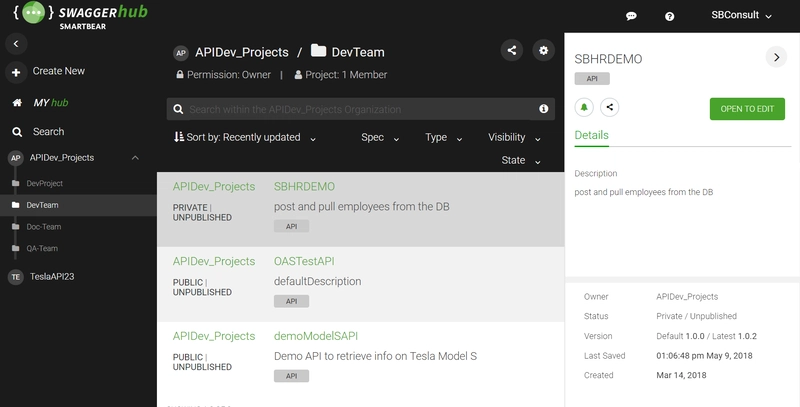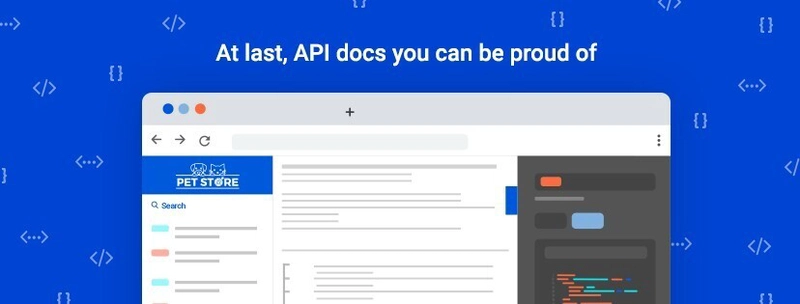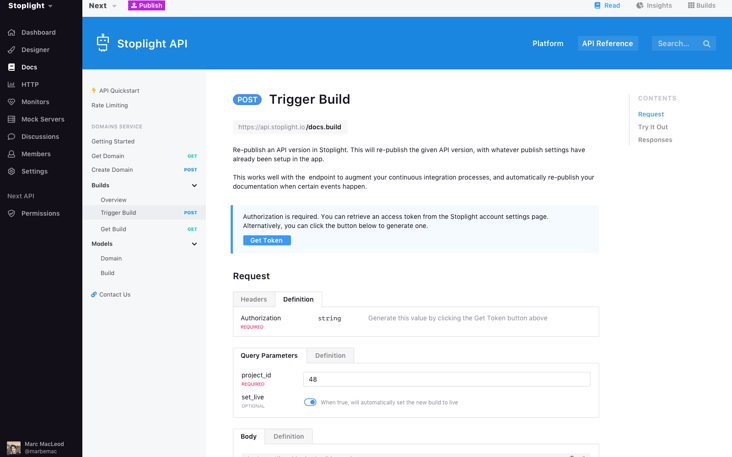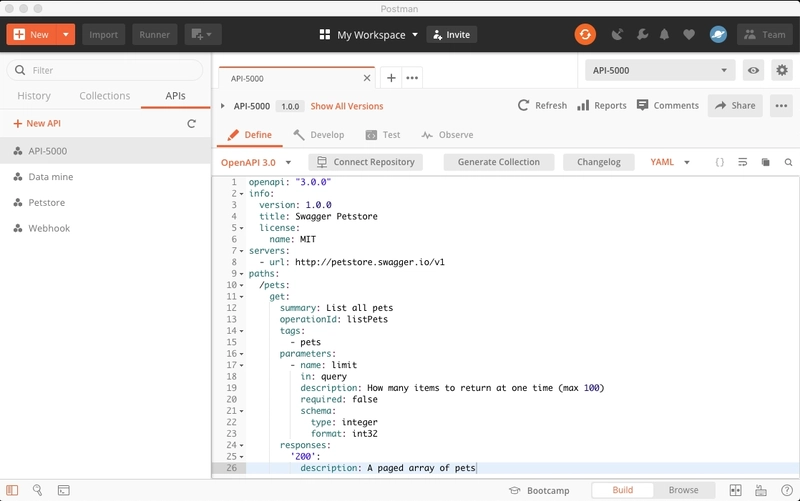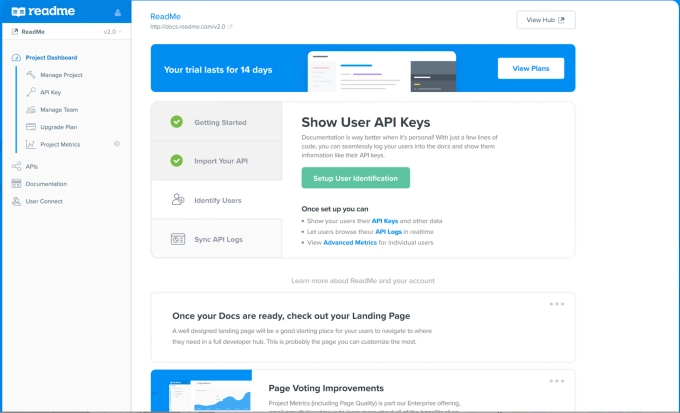7 Top API Documentation Software Tools 2025 (With Reviews and Pricing)✨
Having an API management and documentation system for all your APIs is good, but having a structured formatting tool that streamlines is even better. Here are the top 6 API management and documentation software systems you can use to create structured and detailed API documents. These lifecycle management tools help many streamline their API documentation process with the following features: Included developer portal Usage reporting and API traffic Creating human-readable documentation Creating machine-readable documentation API testing and documentation generator Ability to generate HTML documentation Ability to create developer portals Clean user interface with internal and external users Self-service developer portal Web APIs and GitHub Repository Sample code to develop APIs Handling of API gateways, API calls, and API endpoints 1.Apidog (Comprehensive API Lifecycle Solution) Apidog is a leading choice among API tools for its seamless integration of API design, debugging, and management features into one cohesive platform. Its user-friendly interface and robust functionalities make it a standout choice for teams aiming to streamline their API processes. This platform emphasizes an API Design-first approach, combining an intuitive design environment with comprehensive testing capabilities and documentation support. By offering both local and cloud-based mockup features, Apidog accommodates diverse development and testing needs, enhancing the efficiency and accuracy of API projects. Here are the positives and negatives of Apidog: Pros: Comprehensive API lifecycle management from design to deployment Real-time collaboration tools enhance team communication Supports OpenAPI protocols for precise API specifications Local and cloud-based mockup capabilities for versatile testing environments In-depth documentation features ensure team and stakeholder alignment Cons: May have a learning curve for beginners unfamiliar with API Design-first practices Advanced features might be more than some small teams need Pricing: Free: Available with core features for small teams Professional: Pricing tailored per team requirements with advanced functionalities Enterprise: Custom pricing to fit large organizational needs For more information and to explore subscription options, visit Apidog 2. SwaggerHub (API Management Tool) SwaggerHub tops the list of API documentation tools for its combination of API management, interactivity, ease of use, and compendium of helpful features. This tool is a complete platform that combines Swagger UI (interactive documentation tool) and Swagger Editor (open-source API editor). SmartBear support provides enterprises and individuals a unique set of Rest API documentation functionality in a single ecosystem, improving the overall usability of this API management and documentation suit for effective API lifecycle management. Here are the positives and negatives of SwaggerHub: Pros Complete open-source toolkit for API documentation Automated document generation Fully customizable with open-source code Range of collaboration and real-time team management tools Support for Python, Ruby, HTML, and more Cons It can be expensive for individuals Not as much usability with cloud microservices Pricing Free: $0 (single user, limited functionality) Team: $96 per month (three users, extended functionality) Enterprise: As per client requirements (a minimum of 15 users) For more information and to subscribe, visit SwaggerHub. 3. DapperDox (Open API Renderer) DapperDox is an OpenAPI renderer supporting OAS 2.0 and OAS 3.0 and an open-source server for OpenAPI server specs. The tool allows users to integrate diagrams into their OpenAPI specifications via GitHub Flavored Markdown (GFM). Additionally, users can experiment with document features from inside the documentation using an API explorer. DapperDox is known for its ability to seamlessly bring together diagrams, guides, documentation, and your API specifications. Here are the positives and negatives of DapperDox. Pros Well-written and user-friendly documents Optimized for new users and smaller enterprises More streamlined and more uncomplicated documents It lets you create rich, interactive websites for the APIs Cons Limited compatibility with other APIs Not all third-party extensions work with the tool Pricing Free download available on the website. For more information and to download, visit DapperDox. 4. Redocly Redocly is the full-suite version of Redoc, an OpenAPI-based reference document software that allows integration with various open-source tools. Designed for larger enterprises and more diverse API needs, Redocly provides an OpenAPI specification-compliant method of building interactive and visually pleasing documentation. You can deploy it seamlessly into any continuous integrati
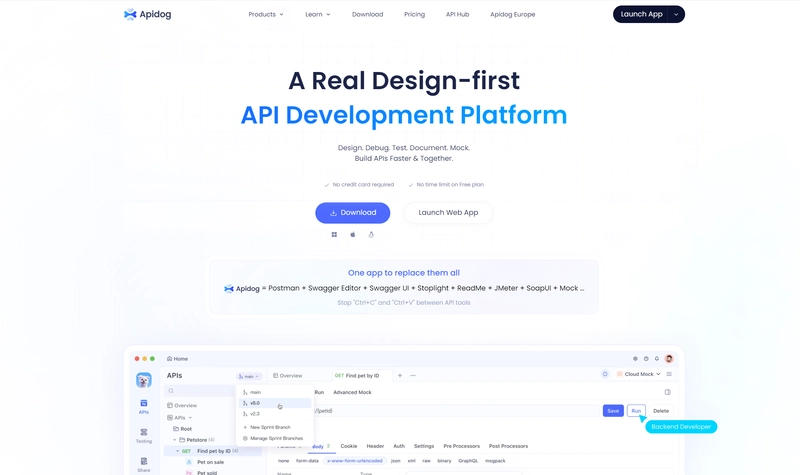
Having an API management and documentation system for all your APIs is good, but having a structured formatting tool that streamlines is even better.
Here are the top 6 API management and documentation software systems you can use to create structured and detailed API documents. These lifecycle management tools help many streamline their API documentation process with the following features:
- Included developer portal
- Usage reporting and API traffic
- Creating human-readable documentation
- Creating machine-readable documentation
- API testing and documentation generator
- Ability to generate HTML documentation
- Ability to create developer portals
- Clean user interface with internal and external users
- Self-service developer portal
- Web APIs and GitHub Repository
- Sample code to develop APIs
- Handling of API gateways, API calls, and API endpoints
1.Apidog (Comprehensive API Lifecycle Solution)
Apidog is a leading choice among API tools for its seamless integration of API design, debugging, and management features into one cohesive platform. Its user-friendly interface and robust functionalities make it a standout choice for teams aiming to streamline their API processes.
This platform emphasizes an API Design-first approach, combining an intuitive design environment with comprehensive testing capabilities and documentation support. By offering both local and cloud-based mockup features, Apidog accommodates diverse development and testing needs, enhancing the efficiency and accuracy of API projects.
Here are the positives and negatives of Apidog:
Pros:
- Comprehensive API lifecycle management from design to deployment
- Real-time collaboration tools enhance team communication
- Supports OpenAPI protocols for precise API specifications
- Local and cloud-based mockup capabilities for versatile testing environments
- In-depth documentation features ensure team and stakeholder alignment
Cons:
- May have a learning curve for beginners unfamiliar with API Design-first practices
- Advanced features might be more than some small teams need
Pricing:
- Free: Available with core features for small teams
- Professional: Pricing tailored per team requirements with advanced functionalities
- Enterprise: Custom pricing to fit large organizational needs
For more information and to explore subscription options, visit Apidog
2. SwaggerHub (API Management Tool)
SwaggerHub tops the list of API documentation tools for its combination of API management, interactivity, ease of use, and compendium of helpful features.
This tool is a complete platform that combines Swagger UI (interactive documentation tool) and Swagger Editor (open-source API editor). SmartBear support provides enterprises and individuals a unique set of Rest API documentation functionality in a single ecosystem, improving the overall usability of this API management and documentation suit for effective API lifecycle management.
Here are the positives and negatives of SwaggerHub:
Pros
- Complete open-source toolkit for API documentation
- Automated document generation
- Fully customizable with open-source code
- Range of collaboration and real-time team management tools
- Support for Python, Ruby, HTML, and more
Cons
- It can be expensive for individuals
- Not as much usability with cloud microservices
Pricing
- Free: $0 (single user, limited functionality)
- Team: $96 per month (three users, extended functionality)
- Enterprise: As per client requirements (a minimum of 15 users)
For more information and to subscribe, visit SwaggerHub.
3. DapperDox (Open API Renderer)
DapperDox is an OpenAPI renderer supporting OAS 2.0 and OAS 3.0 and an open-source server for OpenAPI server specs.
The tool allows users to integrate diagrams into their OpenAPI specifications via GitHub Flavored Markdown (GFM). Additionally, users can experiment with document features from inside the documentation using an API explorer.
DapperDox is known for its ability to seamlessly bring together diagrams, guides, documentation, and your API specifications.
Here are the positives and negatives of DapperDox.
Pros
- Well-written and user-friendly documents
- Optimized for new users and smaller enterprises
- More streamlined and more uncomplicated documents
- It lets you create rich, interactive websites for the APIs
Cons
- Limited compatibility with other APIs
- Not all third-party extensions work with the tool
Pricing
Free download available on the website.
For more information and to download, visit DapperDox.
4. Redocly
Redocly is the full-suite version of Redoc, an OpenAPI-based reference document software that allows integration with various open-source tools.
Designed for larger enterprises and more diverse API needs, Redocly provides an OpenAPI specification-compliant method of building interactive and visually pleasing documentation. You can deploy it seamlessly into any continuous integration that’s currently existing.
This ability extends from the start to the end of the API lifecycle.
Here are the positives and negatives of Redocly.
Pros
- Creates attractive and engaging API documents
- Allows easy deployment throughout the API lifecycle
- Contains highly usable document templates
- Provides automated updates in the cloud
Cons
- Can be expensive for smaller enterprises
- Not enough features on the less expensive packages
Pricing
- Starter: $0 per month (reference documentation access only)
- Basic: $69 per month (added integration and deployment features)
- Professional: $300 per month (full software functionality)
- Enterprise: Customized packages based on enterprise needs
For more information and to subscribe, visit Redocly.
5. Stoplight (API Management for Modern APIs)
Stoplight is a design-centric API documentation software optimized for the modern API workflow.
With an intuitive interface primed for the needs of the more design-heavy API, Stoplight offers a quick and easy solution to designing attractive APIs suitable for both technical and non-technical audiences.
Stakeholders collaborate on JSON schema and OpenAPI-based API designs while featuring mock servers that you can use to test the designs out in real time.
Here are the positives and negatives of Stoplight.
Pros
- A beautiful developer experience
- Fully equipped API design studio
- Ability to scale with consistent updates
- Optimized style guide design features
Cons
- High-end functionality can be expensive for smaller companies
- The free package has minimal design options
Pricing
- Free: $0 per month (limited functions)
- Starter: $99 per month (up to 5 users)
- Professional: $399 per month (up to 10 users)
- Enterprise: Customized pricing (based on enterprise needs)
For more information and to subscribe, visit Stoplight.
6. Postman (API Management for Creation)
Postman is an API documentation tool that provides a machine-readable API document creation platform for singular API developers and developer teams.
The software lets you publish documents easily and quickly. It can automatically populate documentation pages with machine-readable instructions and dynamic examples by pulling code snippets, headers, and sample requests.
Furthermore, Postman lets developers share their APIs with their audience with fewer steps. The internal collaboration features also let bigger developer teams work together and improve documents through code reviews and real-time comments.
Here are Postman’s positives and negatives:
Pros
- Automate updates to all API documents
- High level of share-ability with the ‘Run In Postman’ button
- Accessible communication with machine-readable documents
Cons
- Some instances of software malfunction when sharing multiple API documents
- Has a bit of a learning curve
Pricing
- Free: $0 per user
- Team: $12 per user/month (billed annually)
- Business: $24 per user/month (billed annually)
- Enterprise: Customized packages based on enterprise needs
For more information and to subscribe, visit Postman.
7. ReadMe (API Documentation with Design)
ReadMe is another design-focused documentation platform with a simple, easy-to-use interface and various options that help develop beautiful, streamlined documents.
The software lets developers add API keys directly to the relevant documents, easily create API calls, and generate code samples automatically.
Additionally, ReadMe has some of the best documentation design templates.
Here are the positives and negatives of ReadMe.
Pros
- Helps create documentation and launch APIs quickly
- Ability to develop interactive reference guides
- A fully interactive API development platform
Cons
- Costly enterprise packages
- Some limitations with third-party service integrations
Pricing
- Free: $0 per project/month
- Startup: $99 per project/month
- Business: $399 per project/month
- Enterprise: $2,000 per project/month
For more information and to subscribe, visit ReadMe.
Benefits of API Documentation Software
Having a set of descriptor documents for your API allows people to
- Reduced Need for Support: A well-written and simple set of API documents helps users find their way around the API and not rely on API development support for external customers and internal use.
- Higher Adoption Rate: Documenting helps improve the user experience throughout the API lifecycle and allows users to start working with your API much sooner.
- Extensive Programmability: API documentation uses many programming languages such as PHP, JSON, Java (JavaScript), RAML, and YAML.
- Non-Engineering Usability: Most documentation software produces reference documentation and other material that people with no software engineering experience can easily understand.
- Better Product Maintenance: Documentation gives developers a bird’s eye view of the entire API structure. This allows for better maintenance and updates and quicker improvement cycles.
- API Specs Agreement: Creating complete documents for API allows developers and stakeholders to agree on specifications such as the data, attributes, endpoints, and more.
API documents act as API blueprints and usage tutorials in simple language. Readers don’t need to have developer experience to understand the full capabilities of the API.
Choosing the Right API Documentation Software
The existence of so many high-quality documentation tools has made it easier for technical writers to learn how to write API documentation.
Here are some things you can do to ensure you have the right API documentation software for optimally describing your API.
- Focus on simplicity and ease of use. Developers shouldn’t have to create code snippets for every added feature. The tool should integrate automatically with multiple third-party services.
- Choose a platform that accommodates API documentation with several programming languages and syntax.
- Check if the platform can display your API documentation and allow you to review it with key stakeholders.
- Ensure the software can integrate an external search service such as Google Custom Search, Algolia, or Swiftype.
- Confirm if the software leaves some budget open for third-party hosting and documentation services or offers an in-built deployment option.
- Ensure that you get a platform that gives you technical leeway while still allowing you to make good API content.
- Emphasize the design as the primary quality of documentation software when looking to subscribe. Good API design will allow developers to create more visually appealing documents that better explain API capabilities.
- Good documentation improves user satisfaction to a very high degree. The pleasure is not limited to a narrow audience, as people of all technical expertise can read and use it.
In addition to these pointers, ensure the software pricing suits your short- and long-term budget. It has no bloat or extra functionality you won’t need at the start.
FAQs
Here are the most frequently asked questions about API documentation tools.
What is an API documentation tool, and why is it important?
An API documentation tool helps developers write API documentation efficiently by providing structured templates, automation features, and collaboration support. Well-documented APIs improve usability, streamline integration, and enhance developer experience.
How do API documentation tools improve API docs?
A robust API documentation tool ensures API docs are clear, comprehensive, and up-to-date. It often includes features like interactive API documentation, real-time updates, and built-in testing environments, making it easier for developers to explore and integrate APIs.
Can I automatically generate documentation for my API?
Yes, many API tools can automatically create API documentation from API definitions like OpenAPI or Swagger. This reduces manual effort and ensures the documentation stays aligned with API updates.
Why are code examples essential in API documentation?
Including code examples in API documentation helps developers understand how to implement API calls effectively. High-quality API documentation tools support multiple programming languages and provide interactive examples to simplify integration.
What is an API reference, and how does it differ from other documentation?
An API reference outlines available endpoints, request parameters, response formats, and authentication methods. Unlike tutorials or guides, it is a technical reference for developers who need precise API specifications.
How does interactive API documentation enhance developer experience?
Interactive API documentation allows developers to test API endpoints directly from the documentation. It provides real-time responses, simplifies issues, and helps understand API behavior without writing additional code.
Are there open-source documentation tools for API documentation?
Yes, several open-source documentation tools are available to create API documentation. These tools provide flexibility, customization, and community-driven improvements, making them an excellent choice for teams looking for cost-effective and adaptable solutions. Popular options often support OpenAPI specifications, interactive documentation, and automated updates.











































































































































































![[The AI Show Episode 142]: ChatGPT’s New Image Generator, Studio Ghibli Craze and Backlash, Gemini 2.5, OpenAI Academy, 4o Updates, Vibe Marketing & xAI Acquires X](https://www.marketingaiinstitute.com/hubfs/ep%20142%20cover.png)




























































































































![[DEALS] The Premium Learn to Code Certification Bundle (97% off) & Other Deals Up To 98% Off – Offers End Soon!](https://www.javacodegeeks.com/wp-content/uploads/2012/12/jcg-logo.jpg)


![From drop-out to software architect with Jason Lengstorf [Podcast #167]](https://cdn.hashnode.com/res/hashnode/image/upload/v1743796461357/f3d19cd7-e6f5-4d7c-8bfc-eb974bc8da68.png?#)








































































































.png?#)

































_Christophe_Coat_Alamy.jpg?#)
 (1).webp?#)





































































































![Apple Considers Delaying Smart Home Hub Until 2026 [Gurman]](https://www.iclarified.com/images/news/96946/96946/96946-640.jpg)
![iPhone 17 Pro Won't Feature Two-Toned Back [Gurman]](https://www.iclarified.com/images/news/96944/96944/96944-640.jpg)
![Tariffs Threaten Apple's $999 iPhone Price Point in the U.S. [Gurman]](https://www.iclarified.com/images/news/96943/96943/96943-640.jpg)

































































































































